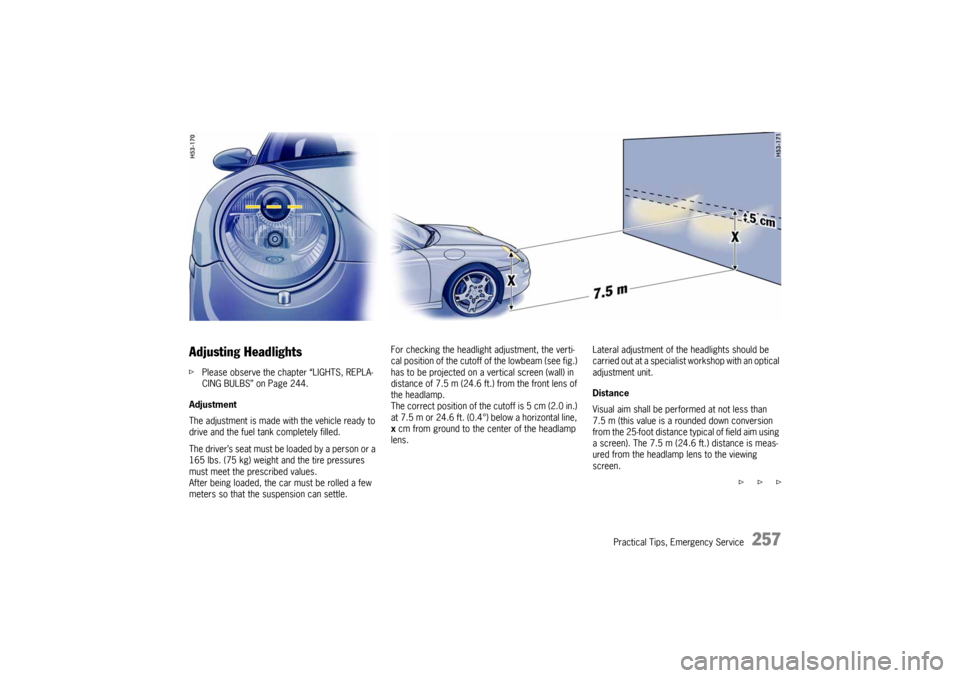fuel pressure PORSCHE 911 CARRERA 2005 5.G Owners Manual
[x] Cancel search | Manufacturer: PORSCHE, Model Year: 2005, Model line: 911 CARRERA, Model: PORSCHE 911 CARRERA 2005 5.GPages: 282, PDF Size: 4.34 MB
Page 13 of 282

Controls, Instruments
13 Controls, Instruments
Before driving off ......................................... 14
Break in hints .............................................. 16
Keys ........................................................... 19
Security Wheel Bolts.................................... 19
Doors ......................................................... 21
Central Lockin ............................................. 22
Alarm System,
Passenger Compartment Monitorin ............... 26
Power Windows ........................................... 28
Inside mirror ................................................ 30
Door Mirrors................................................ 30
Rear Window Defogger,
Door Mirror Heating ..................................... 33
Seat Adjustment .......................................... 34
Seat Memory ............................................... 36
Heated Seats .............................................. 38
Rear Seat Backrests.................................... 39
Steering Wheel Adjustment ........................... 39
Multi-Functional Steering Wheel ..................... 40
Sun Visors................................................... 41
Safety Belts................................................. 42
Child Restraint Anchorages ........................... 45
Child Restraint Systems ............................... 46
LATCH System
Child seat bracket on the passenger’s seat .... 48
Key-operated airbag deactivation device ........ 49
Airbag Systems ........................................... 50
Rollover Protection System........................... 52
Parking Aids ................................................ 53
Retractable Rear Spoiler............................... 56
Clutch Pedal ................................................ 58
Parking Brake .............................................. 58Brakes ........................................................ 59
ABS Brake System
(Antilock Brake System)................................ 62
Sport Mode ................................................. 64
Porsche Stability Management (PSM)............. 65
Porsche Active Suspension
Management (PASM) .................................... 68
Interior Lights .............................................. 69
Operation, Instruments ................................. 70
Ignition/Starter Switch with anti-theft
Steering Lock .............................................. 72
Starting Procedures ..................................... 74
Stopping Engine .......................................... 75
Instrument Panel USA Models ....................... 76
Instrument Panel Canada Models................... 78
Engine oil temperature ................................. 80
Automatic Speed Control Indicator light ......... 80
Instrument Illumination.................................. 80
Trip Odometer ............................................. 81
Speedometer .............................................. 82
Changing over between
Miles / Kilometers........................................ 82
Tachometer................................................. 83
Turn Signal Indicator Light ............................ 83
High Beam .................................................. 83
Cooling System ........................................... 84
Tiptronic ..................................................... 85
Fuel ............................................................ 86
Clock .......................................................... 87
Outside temperature .................................... 87
Engine Oil Pressure ...................................... 88
Check Engine Warning Light.......................... 89On-Board Computer (BC).............................. 90
Emergency Flasher Switch .......................... 112
Light Switch .............................................. 113
Welcome Home Lighting............................. 113
Automatic Headlight Beam Adjustment......... 114
Turn Signal / Headlight Dimmer /
Parking light / Flasher Lever ....................... 114
Windshield Wiper / Washer Lever ................ 115
Automatic Speed Control ............................ 118
Automatic Air Conditioning System .............. 120
Central and Side Vents ............................... 123
Fresh-air Intake .......................................... 123
Ashtray ..................................................... 124
Cigarette Lighter ........................................ 125
Cupholder ................................................. 126
Storage in the Passenger Compartment ...... 128
Luggage Compartment Lid and
Engine Compartment Lid ............................ 130
Luggage Compartment............................... 132
Trunk Entrapment ....................................... 133
Fire Extinguisher ........................................ 135
HomeLink .................................................. 136
Porsche Communication
Management (PCM) .................................... 139
Car Telephone and Aftermarket Alarms........ 142
Page 76 of 282

76
Controls, Instruments
Instrument Panel USA Models Also refer to the corresponding chapters in
the Owner’s Manual.
1. Engine oil temperature gauge
2. Speedometer with analogue display
3. Turn signal indicator light, left
4. Tachometer
5. High beam indicator light
6. Turn signal indicator light, right
7. ABS warning light
8. Cooling system
Temperature gauge, warning light
9. Fuel
Level gauge, warning light
10.Engine oil pressure gauge
11.Adjustment button for instrument illumination
and trip counter
12.Odometer and daily trip mileage display
13.Automatic speed control indicator light14.Light sensor for instrument illumination
15.Airbag warning light
16.Emission control warning light
(Check Engine)
17.Central warning light
18.On-board computer display
19.Porsche Stability Management
Multifunctional PSM light
20.Brake warning light
21.Safety belt warning light
22.Tiptronic indicator
23.Clock and outside temperature display
24 Adjustment button for clockWhen the ignition is switched on, the warning
lights light up for a lamp check.
Note
Warnings that have been given are stored in the
appropriate control unit memory and can be read
out at an authorized Porsche dealer.
This information can help to warn you about situa-
tions which may be hazardous to you or your car.
Page 78 of 282

78
Controls, Instruments
Instrument Panel Canada Models Also refer to the corresponding chapters in
the Owner’s Manual.
1. Engine oil temperature gauge
2. Speedometer with analogue display
3. Turn signal indicator light, left
4. Tachometer
5. High beam indicator light
6. Turn signal indicator light, right
7. ABS warning light
8. Cooling system
Temperature gauge, warning light
9. Fuel
Level gauge, warning light
10.Engine oil pressure gauge
11.Adjustment button for instrument illumination
and trip counter
12.Odometer and daily trip mileage display
13.Automatic speed control indicator light14.Light sensor for instrument illumination
15.Airbag warning light
16.Emission control warning light
(Check Engine)
17.Central warning light
18.On-board computer display
19.Porsche Stability Management
Multifunctional PSM light
20.Brake warning light
21.Safety belt warning light
22.Tiptronic indicator
23.Clock and outside temperature display
24 Adjustment button for clockWhen the ignition is switched on, the warning
lights light up for a lamp check.
Note
Warnings that have been given are stored in the
appropriate control unit memory and can be read
out at an authorized Porsche dealer.
This information can help to warn you about situa-
tions which may be hazardous to you or your car.
Page 107 of 282

Controls, Instruments
107
Fuel gauge war-
ning lightPlease observe range
on remaining fuelRefuel at next opportunity.
Check the oil level Start engine oil level measurement in the
on-board computer.
The vehicle must be horizontal and the ignition
must be switched on.
Oil pressure too low Stop immediately at a suitable place, measure
oil level with the on-board computer and, if ne-
cessary, add engine oil.
Warning light
Temperature gau-
geEngine temperature too high Switch engine off and let it cool.
Check coolant level and, if necessary,
add coolant.
Temperature gau-
ge warning light
flashesCheck coolant level Switch engine off and let it cool.
Check coolant level and, if necessary, add
coolant.
Engine diagnostics – workshop Consult your authorized Porsche dealer.
Reduced engine performance Consult your authorized Porsche dealer.
Temperature gau-
ge warning light
flashesFailure of
engine-compartment blowerConsult your authorized Porsche dealer.
Battery/generator warning Stop at a safe place and switch the engine off.
Do not continue driving.
Have the fault remedied at an authorized
Porsche dealer.
Oil pressure gauge faulty Have the fault remedied at an authorized
Porsche dealer.
Oil level display faulty Have the fault remedied at an authorized
Porsche dealer.Instrument
panelOn-board
computerText display on on-board
computerMeaning/measure
Page 181 of 282

Maintenance, Car Care
181
Engine Oil Engine oil consumption
It is normal for your engine to consume oil.
The rate of oil consumption depends on the quality
and viscosity of oil, the speed at which the engine
is operated, the climate, road conditions as well
as the amount of dilution and oxidation of the
lubricant.
If the vehicle is used for repeated short trips, and
consumes a normal amount of oil, the engine oil
measurement may not show any drop in the oil
level at all, even after 600 miles (1,000 km) or
more. This is because the oil is gradually becom-
ing diluted with fuel or moisture, making it appear
that the oil level has not changed.
The diluting ingredients evaporate out when the
vehicle is driven at high speeds, as on an express-
way, making it then appear that oil is excessively
consumed after driving at high speeds.
If the conditions you drive your vehicle in are
dusty, humid, or hot, the frequency of the oil
change intervals should be greater. If the vehicle is driven at a high rate of speed,
climatic conditions are warm, and the load is high,
the oil should be checked more frequently, as
driving conditions will determine the rate of oil
consumption.
– The engine in your vehicle depends on oil to
lubricate and cool all of its moving parts.
Therefore, the engine oil should be checked
regularly and kept at the required level.
– Make it a habit to have the engine oil level
checked at every fuel filling.
– The oil pressure warning light is not an oil level
indicator.
The oil pressure warning light indicates serious
engine damage may be occuring when lit, if en-
gine rpm is above idle speed.
Engine Oil Level fPlease observe the chapter “EXERCISE EXTRE-
ME CAUTION WHEN WORKING ON YOUR VE-
HICLE” on Page 178.
fRegularly check the oil level using the on-board
computer after the vehicle is refuelled.
Please observe the chapter “OIL DISPLAY AND
MEASUREMENT OF THE ENGINE OIL LEVEL”
on Page 101.
The difference between the minimum and maxi-
mum marks on the segment display is approx.
1.2 liters.
Each segment of the display corresponds to ap-
prox. 0.4 liter.
f f f
Page 187 of 282

Maintenance, Car Care
187
Fuel Economy Fuel economy will vary depending on where,
when and how you drive, optional equipment
installed, and the general condition of your
car.
A car tuned to specifications and correctly
maintained, will help you to achieve optimal
fuel economy.
fHave your vehicle tuned to specifications.
Air cleaner should be dirt free to allow proper
engine “breathing”.
Battery should be fully charged.
Wheels should be properly aligned.
Tires should be inflated at correct pressure.
fAlways monitor your fuel consumption.
fDrive smoothly, avoid abrupt changes in speed
as much as possible.
fAvoid jack rabbit starts and sudden stops.
fDo not drive longer than necessary in the lower
gears. Shifting into a higher gear early without
lugging the engine will help save fuel.
fProlonged “warm up” idling wastes gas. Start
the vehicle just before you are ready to drive.
Accelerate slowly and smoothly.
fSwitch off the engine if stationary for longer
periods. fAny additional weight carried in the vehicle re-
duces fuel economy. Always keep cargo to a
minimum and remove all unnecessary items.
fOrganize your trips to take in several errands
in one trip.
fAll electrical accessories contribute to in-
creased fuel consumption.
fOnly switch on the air conditioning when neces-
sary.
fDo not drive with the Roof Transport System
mounted unless you need it.
The EPA estimated m.p.g. is to be used for
comparison purposes, actual mileage may
be different from the estimated m.p.g.,
depending on your driving speed, weather
conditions and trip length. Your actual
highway mileage will probably be less than
the estimated m.p.g.
fPlease observe all local and national speed
limits.
Operating Your Porsche in other
Countries Government regulations in the United States and
Canada require that automobiles meet specific
emission regulations and safety standards. There-
fore, cars built for the U.S. and Canada differ from
vehicles sold in other countries.
If you plan to take your Porsche outside the conti-
nental limits of the United States or Canada, there
is the possibility that
– unleaded fuel may not be available;
– unleaded fuel may have a considerably lower
octane rating. Excessive engine knock and se-
rious damage to both engine and catalytic con-
verters could result;
– service may be inadequate due to lack of prop-
er service facilities, tools or diagnostic equip-
ment;
– replacement parts may not be available or very
difficult to get.
Porsche cannot be responsible for the
mechanical damage that could result
because of inadequate fuel, service or parts
availability.
If you purchased your Porsche abroad and want to
bring it back home, be sure to find out about ship-
ping and forwarding requirements, as well as cur-
rent import and customs regulations.
Page 206 of 282

206
Maintenance, Car Care
Alcantara fDo not use a leather care product to clean
Alcantara.
For regular care it is sufficient to clean the cover
with a soft brush.
Cleaning when lightly soiled
fWet a soft cloth with water or a neutral soap
solution and wipe off the dirt.
Cleaning when heavily soiled
fWet a soft cloth with lukewarm water or
thinned white spirit and dab the dirt from the
outside in. Safety belts If it becomes necessary to clean the belts, you
can use any mild washing agent.
Allow the belts to dry prior to retracting, but avoid
direct sunlight.
fOnly use suitable cleaners.
If unsuitable cleaners are used or any attempt
is made to dye or bleach the belts, the web-
bing may be weakened and thus constitute a
safety risk.
Storing your Porsche If you intend to store your Porsche for a prolonged
period, please consult your authorized Porsche
dealer. The staff will be glad to advise you on the
most suitable and necessary methods.
fClean your vehicle thoroughly inside and out-
side.
Clean the engine compartment.
The under carriage and chassis components
should be free of dirt and salt deposits.
fFill up the fuel tank.
fChange the oil and oil filter, and run the engine
for several minutes.
fIncrease the tire pressure to 58 psi (4 bar).
It is not recommended to lift the vehicle, due to
the possibility of corrosion on shock absorber
piston shafts.
The vehicle should be moved slightly, approxi-
mately every four weeks, to prevent flat spot
on the tires. Climate control
The air conditioning system should be in good
working condition and fully charged.
Windshield/Headlight washer
fCheck and correct antifreeze/cleaning solution
level as necessary.
Electrical system
fRemove the battery from the vehicle and store
it in a cool dry place, not on a cement floor.
When the battery is disconnected, the
alarm system is deactivated.
fRecharge the battery every 3 months. If the
battery remains in the vehicle with the cables
connected, it is necessary to check, remove
and recharge the battery every 2-3 weeks.
Do not fast charge the battery.
fPlease observe the chapter “BATTERY” on
Page 236.
Vehicle interior
The interior must be dry, especially in the area of
the floor carpets. The use of drying agents (Silica-
Gel) is recommended in vehicles with leather inte-
rior and in areas with high humidity. The recom-
mended amount is 3 fabric bags of 1.1 lbs.
(500 grams) each placed on the floor carpets.
Windows, doors and lids must be closed. The air
vents should be opened.
Page 215 of 282

Practical Tips, Emergency Service
215
Tire care fAvoid damaging tires and wheel rims.
fIf you must drive over a curb or other obstacle,
drive slowly and at an obtuse angle.
fCheck tires for uneven wear and damage
before driving off.
fRemove imbedded material.
fReplace worn or damaged tires immediately.
fKeep oil, fuel, brake fluid, etc. away from tires.
fReplace missing valve stem caps.
fKeep tires inflated correctly.
fWash tires when washing the vehicle. Also
clean inner side of wheels.
fDo not use abrasive cleaners when washing
the wheels.
fCheck wheel rims for corrosion.
fRemove road salt, if driving in winter.
Tire damage, puncture fCheck tires for imbedded material, cuts, punc-
tures, cracks and bulges (side wall) before driv-
ing off.
In case of tire damage, where it is uncertain wheth-
er there is a break in the ply with all its conse-
quences or tire damage caused by thermal or me-
chanical overloading due to loss of pressure or
any other prior damage, we recommend that the
tire be replaced for safety reasons.
If one faulty tire is replaced it should be noted that
the difference in tread depth on one axle must not
exceed 30%.
Handling inconsistencies may result.
fPerform a visual inspection if necessary.
Danger!
Risk of serious personal injury or death.
Driving the vehicle with low tire pressure
increases risk of a tire failure and resulting
loss of control. Furthermore, low tire pres-
sure increases rate of wear of the affected
tires.
fCheck tires – including sidewalls – regularly for
foreign bodies, nicks, cuts, cracks and bulges.
fAfter driving off road, examine tires for signs
of damage such as cuts, tears, bulges or for-
eign objects stuck in the tread. Replace a dam-
aged tire if necessary.
fCross curb edges slowly and at right angles if
possible.
Avoid driving over steep or sharp curbs.
fIn cases of doubt, have the wheel (particularly
the inner side) checked by an authorized Porsche dealer.
Page 257 of 282

Practical Tips, Emergency Service
257
Adjusting HeadlightsfPlease observe the chapter “LIGHTS, REPLA-
CING BULBS” on Page 244.
Adjustment
The adjustment is made with the vehicle ready to
drive and the fuel tank completely filled.
The driver’s seat must be loaded by a person or a
165 lbs. (75 kg) weight and the tire pressures
must meet the prescribed values.
After being loaded, the car must be rolled a few
meters so that the suspension can settle.
For checking the headlight adjustment, the verti-
cal position of the cutoff of the lowbeam (see fig.)
has to be projected on a vertical screen (wall) in
distance of 7.5 m (24.6 ft.) from the front lens of
the headlamp.
The correct position of the cutoff is 5 cm (2.0 in.)
at 7.5 m or 24.6 ft. (0.4°) below a horizontal line,
x cm from ground to the center of the headlamp
lens. Lateral adjustment of the headlights should be
carried out at a specialist workshop with an optical
adjustment unit.
Distance
Visual aim shall be performed at not less than
7.5 m (this value is a rounded down conversion
from the 25-foot distance typical of field aim using
a screen). The 7.5 m (24.6 ft.) distance is meas-
ured from the headlamp lens to the viewing
screen.
f f f
Page 279 of 282

Index
279
Compact disc
Player and Changer ............................. 141
Storage.............................................. 129
Compartment monitoring............................... 26
Convertible top ........................................... 156
Care .................................................. 200
Coolant ................................................84
, 179
Level.................................................. 179
Temperature gauge.............................. 84
Warning light ........................................ 84
Cooling system .....................................84, 179
Cruise control .............................. 88
, 118
, 119
Cupholder .................................................. 126
DDashboard ................................................... 70
Data bank .................................................. 262
Defrosting windows ...............................33
, 121
Diagnostic socket .................................17, 234
Diagrams ................................................... 273
Dimensions ................................................ 272
Door ............................................................ 21
Guard lights ........................................ 255
Handles................................................ 21
Locks...........................................21, 201
Mirror .................................................. 32
Mirror heating ....................................... 33
Windows ....................... 21
, 28, 156
, 203
Driving hints ................................................. 14
Driving in winter .......................................... 150
Driving performance ................................... 271
Drop-center rim .......................................... 221
DVD Navigation...................................132, 139
EElectrical system.........................................232
Emergency flasher ......................................112
Emergency operation
Central locking ......................................23
Lids ...................................................235
Sliding roof .........................................154
Tank flap ............................................188
Emergency service......................................208
Emergency starting
with jumper cables............................. 242
, 243
Emission control system ........... 7
, 89, 191
, 192
Engine
Checking the oil level ...........................101
Exhaust ..................................................9
Number ..............................................263
Oil consumption........................... 16, 181
Oil level ..............................................181
Oil level indicator.................................101
Oil pressure ..........................................88
Oil temperature .....................................80
Oils ........................................... 181, 268
Speeds ....................................... 16, 271
Starting ................................................74
Stopping ..............................................75
Engine compartment
Blower .......................................... 75, 84
Lid ............................................ 130, 131
Lid warning light ..................................130
Light ..................................................255
Environment ...................................................6
FFilling pressure, tire................................ 5
, 267
Fire extinguisher......................................... 135
Floor mats ................................................. 205
Fluids and fuels .......................................... 268
Fog lights .................................................. 113
Footbrake .................................................... 59
Footwell lights ............................................ 255
Fresh air intake .......................................... 123
Front lid ..................................................... 131
Fuel................................................. 4
, 86, 188
Containers ..................................... 8, 190
Economy ........................................... 187
Evaporation control ............................ 193
Level gauge ......................................... 86
Level warning light................................ 86
Recommendation ....................... 189, 190
Tank.................................................. 189
Function keys ............................................... 40
Fuses ........................................................ 234
GGarage door opener................................... 136
Garage lift ................................................. 224
Glove compartment .................................... 129
Gong ....................................... 18
, 73, 92, 113
Ground clearance ........................................... 9